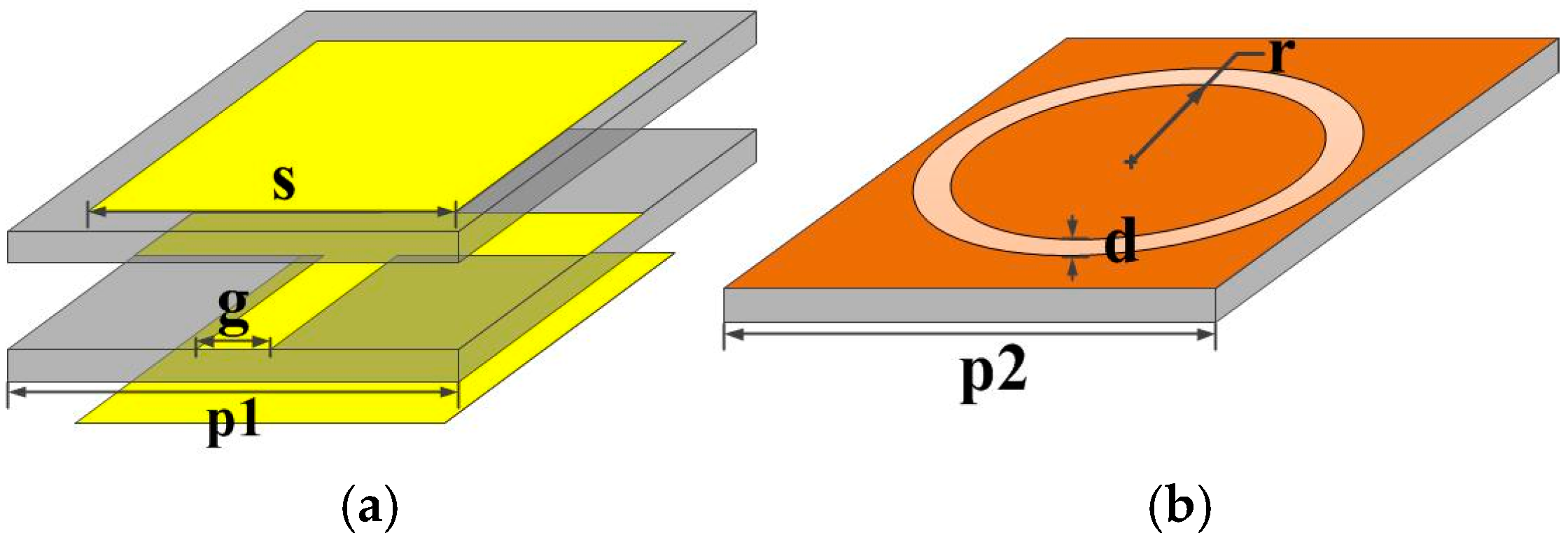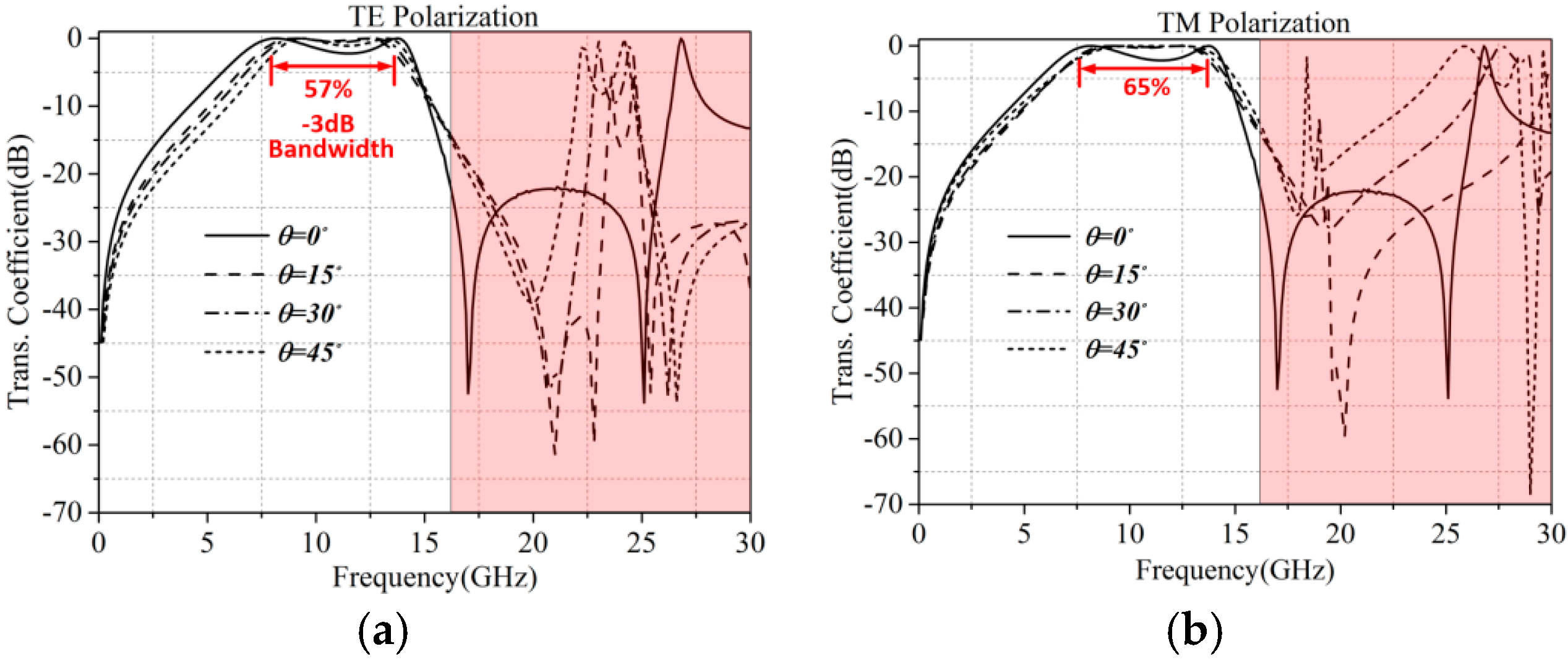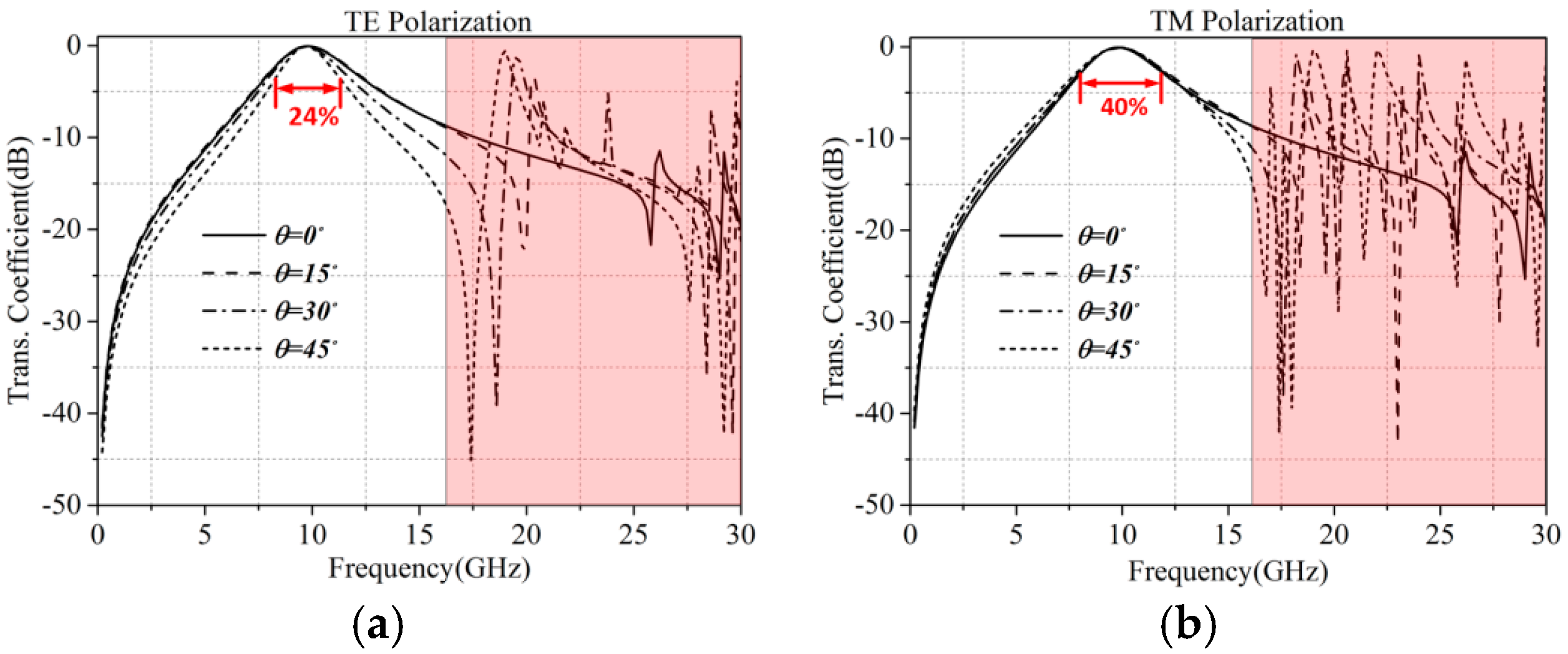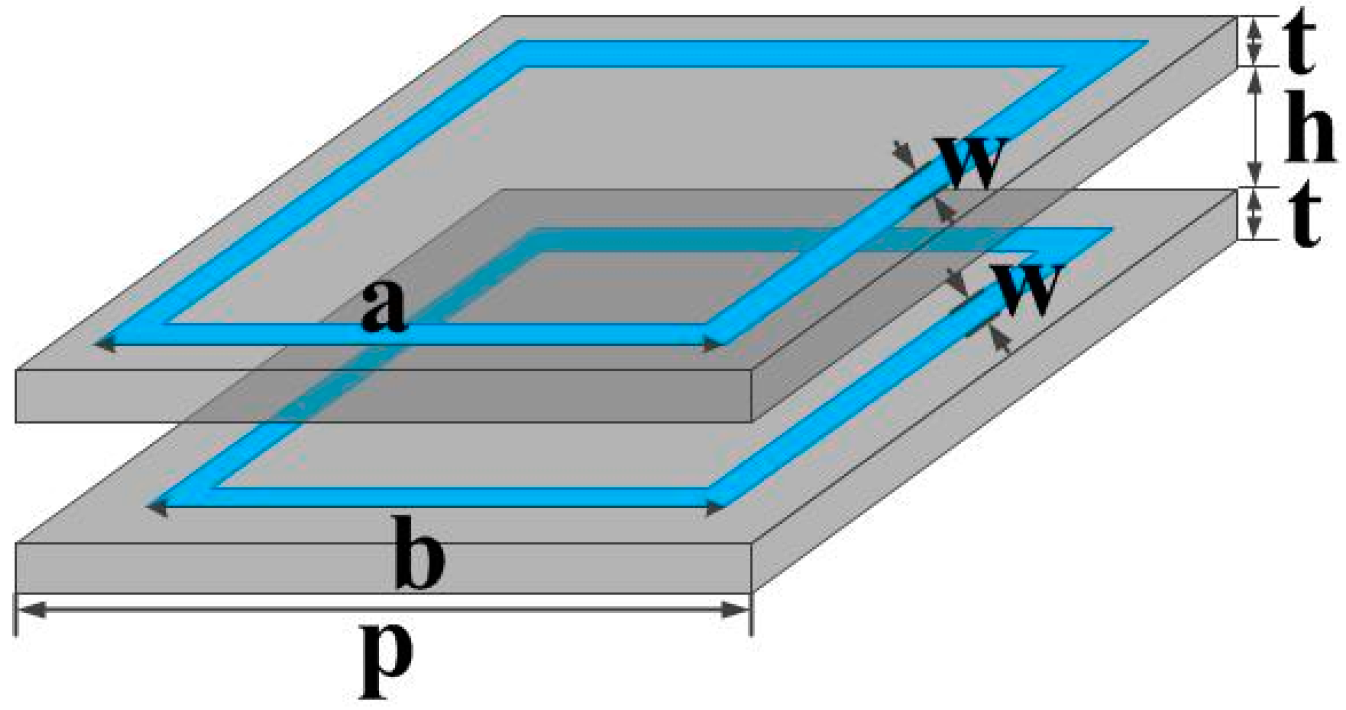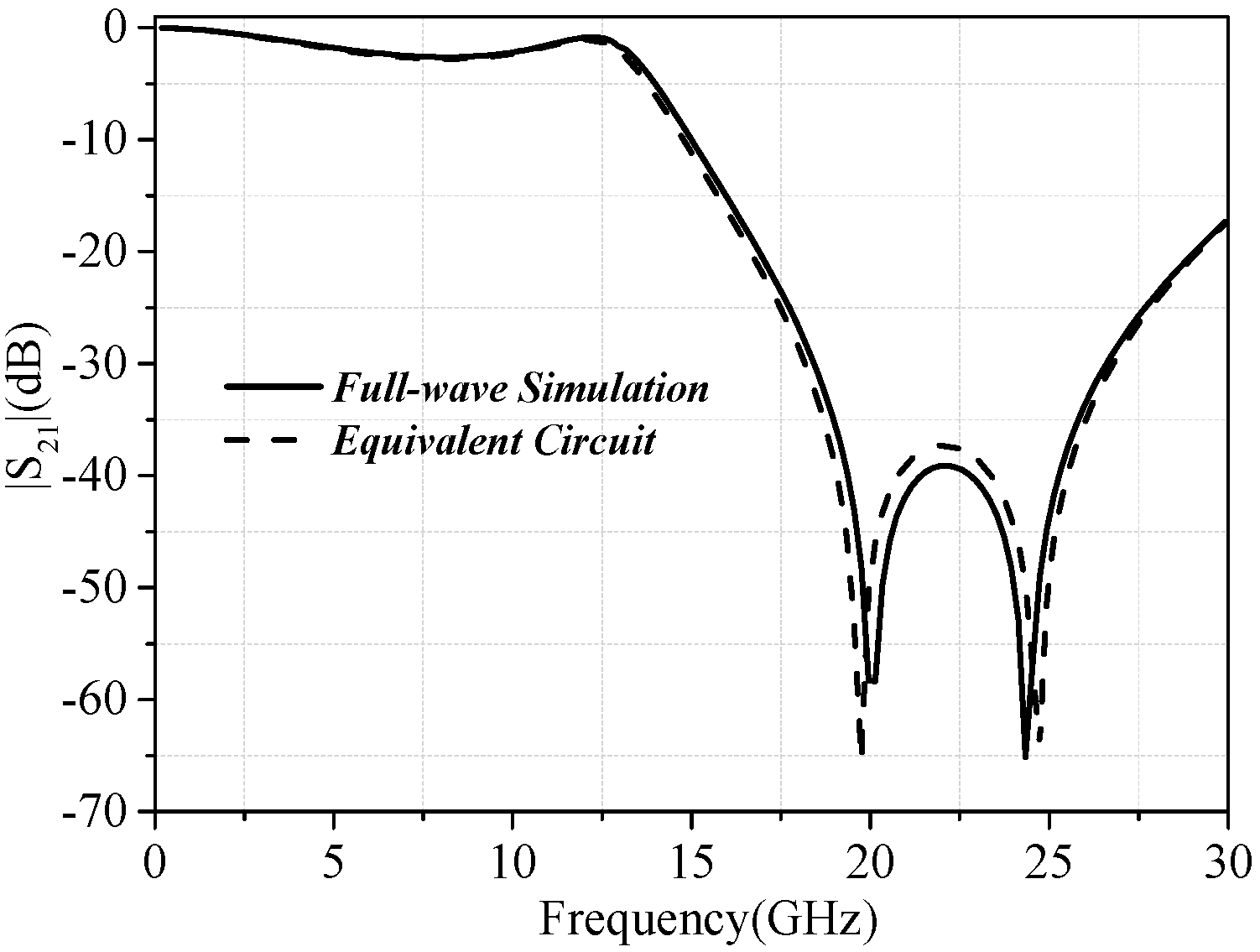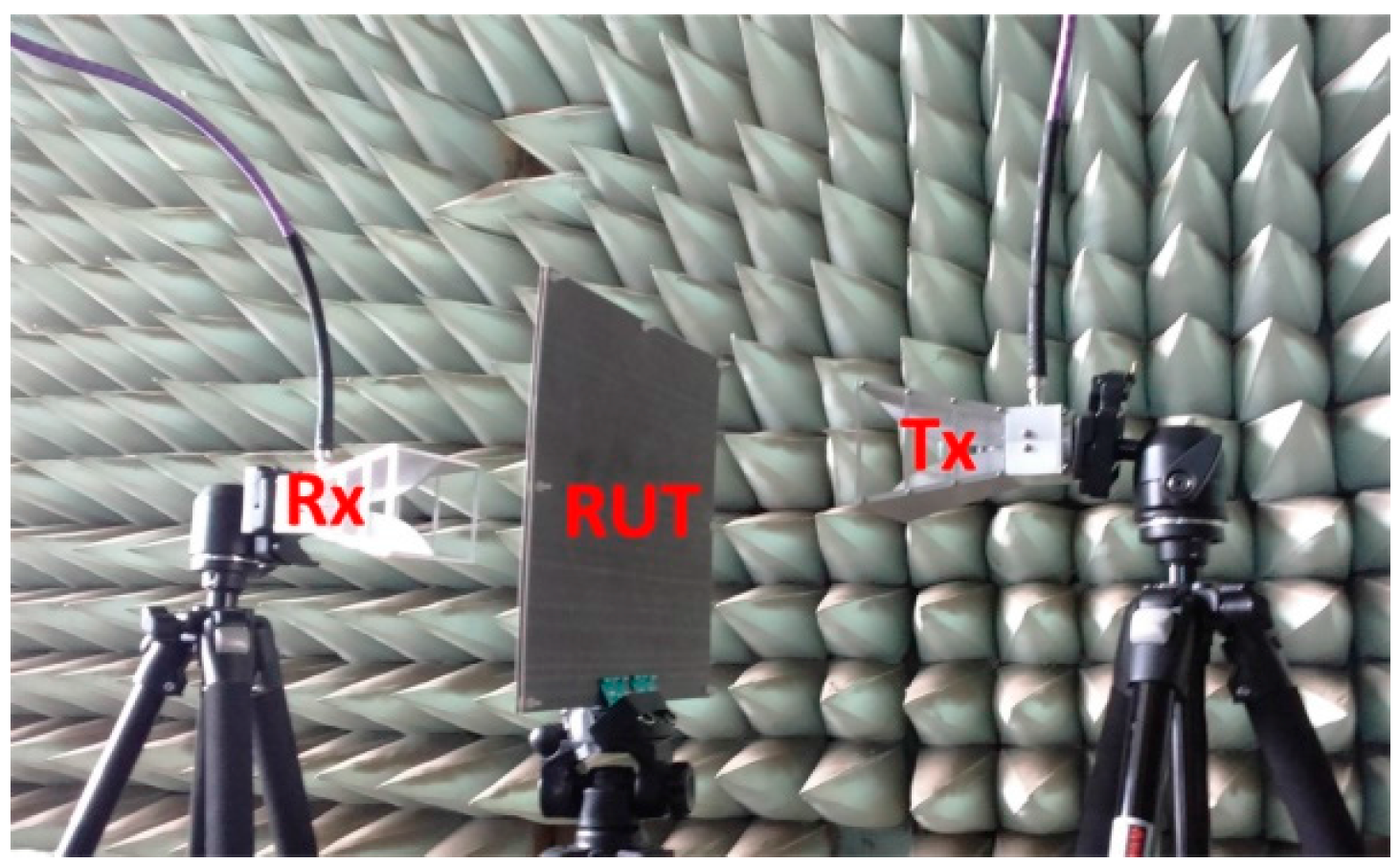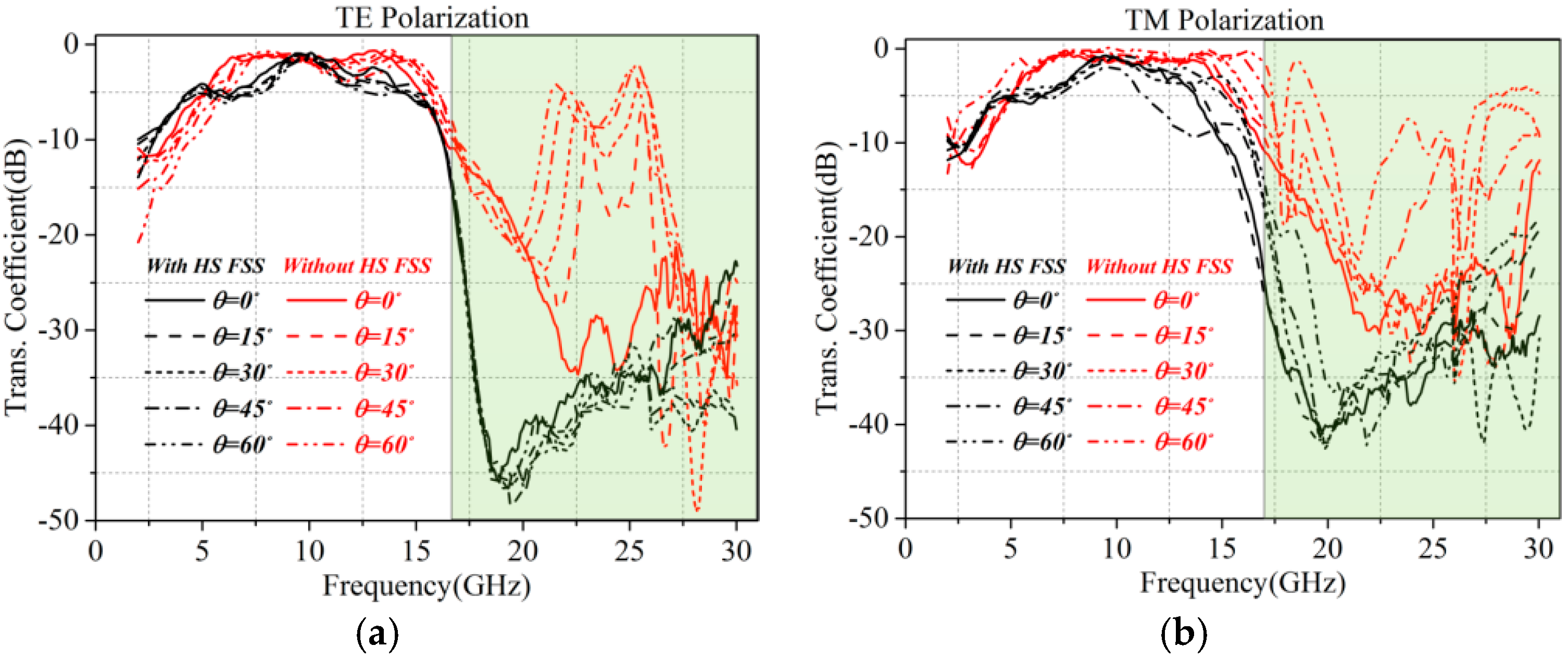1. Introduction
Metasurfaces have been widely applied in manipulation of electromagnetic wave, such as radar radomes [
1], spatial filters [
2], reflect arrays [
3], artificial impedance surfaces [
4], polarization converters [
5], and absorbing materials [
6], etc., because of their properties of allowing uninhibited transmission of electromagnetic waves in specific frequency bands while suppressing transmission in other undesired bands. In general, a band-pass spatial filter based on metasurface is also called frequency selective surface (FSS) which is transparent within the operation frequency band of the antenna and opaque at other frequencies. However, most FSSs have multiple spurious transmission windows in higher operating frequency bands. And the high frequency harmonic phenomenon will severely interfere with other antennas and radars which operate at the h-armonic frequency bands especially on the low-observable or stealth platforms. As a result, the FSSs with harmonic suppression feature are important for practical applications.
In [
7,
8,
9], band-pass frequency selective surfaces with stop-band characteristics are reported. They use artificial absorbing coating, resistive high-impedance surface, and other techniques to achieve the harmonic absorbing properties. However, the FSSs in these designs are specific which means the technique of these harmonic suppression FSSs cannot be independent and transplanted. In this paper, a transplantable frequency selective metasurface element for harmonic suppression is designed. The frequency selective metasurface element (FSMSE) are integrated with two different types of band-pass FSSs to remove the spurious transmission windows outside of the desired operational pass-band, respectively. Full-wave simulations and experiments show feasibility of the harmonic suppression FSMSE, and measured results agree well with simulated ones.
2. Design of the Harmonic-Suppression Frequency Selective Metasurface Element (FSMSE)
In general, a FSS with band-pass feature intrinsically has spurious transmission windows outside of the desired operational pass-band. For an example, a classic non-resonant FSS [
7] which consists of square metallic patch with fishnet grids in multilayer structure is shown in
Figure 1a. Full-wave analyses show that the pass-band characteristic of the FSS is operating at about 10 GHz, but with harmonic transmission bands around 25 GHz, as shown in
Figure 2. When the plane wave is oblique incidence with Transverse Electric (TE) and Transverse Magnetic (TM) polarizations, the spurious transmission windows become much more. Similarly, a typical resonant type FSS which is composed of complementary loop structure [
10] is shown in
Figure 1b, which also operates at 10 GHz. Because the FSS is resonant structure, it has several harmonic pass bands at the higher frequency bands outside of the main pass-band, as shown in
Figure 3. The geometry parameters of the two FSSs are shown in
Table 1. Thus it can be seen that the harmonic suppression technique should be adopted. In this paper, a transplantable FSMSE is proposed that can be integrated with different types of band-pass FSS structures without deteriorating the operating frequency of the pass band.
The topology of the FSMSE for harmonic suppression is shown in
Figure 4, which is composed of two-layer square loop elements that intrinsically own band-stop feature. It is known that the single-layer square loop FSMSE has a narrow stop band whose operating frequency could be adjusted by changing the length of square loop. As a result, when we want to obtain a relatively wide stop band, the multilayer square loop FSMSE with air spacing can be designed. At the same time, the pass band of 10 GHz has to be guaranteed. The equivalent circuit model is used to analyze the feature of the FSMSE for harmonic suppression, as shown in
Figure 5.
Here the square loop element can be equivalent to a band stop circuit. As a result, the equivalent circuit of the two-layer square loop FSMSE is a two-stage cascaded circuit which is connected by a uniform transmission line whose length depends on the electric size of the air spacing, as shown in
Figure 5. The geometry parameters are shown in
Table 2. The lumped elements in the equivalent circuit can be obtained using bisquare fitting algorithm [
11]. According to the equivalent circuits of each layer of the square loop FSMSE, the lumped parameters are extracted as follows:
L1s =
L1s1 = 0.0834 nH,
L2s =
L2s1 = 0.001 nH,
C2s = 0.6677 pF,
C2s1 = 0.4462 pF,
L3s = 0.0762 nH,
L3s1 = 0.0624 nH,
C3s = 0.1834 pF and
C3s1 = 0.2167 pF. With these lumped elements and the circuit prototype, the optimal air spacing h could be obtained using circuit optimization. It can be seen that when h equals to 2 mm, the maximum stop-band range can be obtained.
Figure 6 depicts the comparison of transmission coefficient of the harmonic suppression FSMSE between the full-wave simulation and the equivalent circuit, which shows good agreement with each other. Furthermore, the oblique incidences of TE and TM polarizations with different incident angles on the harmonic suppression FSMSE are analyzed, respectively, as shown in
Figure 7. It can be seen that the proposed FSMSE has good polarization and angle stability. And the −20 dB suppression bandwidth is from 16.8 to 26.8 GHz.
Next, the designed harmonic suppression FSMSE can be integrated with the aforementioned non-resonant patch-grid FSS and the resonant complementary loop FSS, respectively, as shown in
Figure 8 and
Figure 9. The air spacing h1 between the two original FSSs and the HS-FSMSE was also optimized using circuit analysis where the two types of FSSs are equivalent to band-pass circuits whose lumped elements can also be extracted by bisquare fitting algorithm. When h1 is 3 mm, the harmonic suppression feature can perfectly be achieved without deteriorating the operating frequency of the pass band.
Figure 10 shows the transmission coefficient of non-resonant patch-grid FSS with HS-FSMSE for different incidence angles with TE and TM polarizations. It can be seen that the high-order harmonic waves can be suppressed below −40 dB after integrating with HS-FSMSE structure. Similarly,
Figure 11 depicts the transmission coefficient of the resonant complementary loop FSS with HS-FSMSE for different incidence angles with TE and TM polarizations. The results show that the high-order harmonic waves can also be well suppressed even with the strong resonant behavior. In the meantime, we can see that the two different types of FSSs with same HS-FSMSE own good polarization and angle stabilities. It can be seen that the FSS with narrower bandwidth will be less affected after HS-FSMSE is added. Hence, cascading HS-FSMSE layers to suppress spurious transmission of band pass FSS filters could be used for the applications which needs relatively narrow pass band.
It is worth pointing out that the unit cell size of the patch-grid FSS and the complementary loop FSS are different. The patch-grid FSS is sub-wavelength structure whose period is only 6.6 mm, and the complementary loop is a conventional resonant structure whose period is 10 mm. For two different FSSs, the unit cell size of the harmonic suppression FSMSE is the same as 3.3 mm. As a result, when the HS-FSMSE is integrated with the patch-grid FSS, one unit corresponds to 2
2 HS-FSMSEs. And for the resonant complementary loop FSS, one unit corresponds to 3
3 HS-FSMSEs, as shown in
Figure 8 and
Figure 10, respectively. In this case, the different implementations show the transplantability of the HS-FSMSE.
3. Experimental Verification
In this section, a prototype of the patch-grid FSS integrating with HS-FSMSE has been fabricated, as shown in
Figure 12. The fabricated prototype has five layers of metal structure printed on four substrates with dielectric constant
and the loss tangent of 0.003. The layers are separated by air with plastic screws. The total size of the fabricated FSS is 235
235
7 mm. The air spacing is 3 and 2, respectively. Since the dimension of the fabricated FSS is relatively small especially in the far-field environment which will make the diffraction becomes strong, we use the two-port method in the near-field region to measure the transmission feature of FSS. In the measurement, we measured the transmission and reflection characteristics of the two horns measurement system without FSMSE for calibration. The near field coupling effect can be eliminated. For frequency selective surfaces, the features do not vary with different kinds of electromagnetic wave. The plane wave setup in the simulation is mean to model the far-field environment. Since we have removed the near-field coupling effect, the measurement results could be equal to the theoretical model when the plane wave is incident on the FSS.
Experiments were performed by using three pairs of transmitting and receiving horn antennas that can cover different frequency ranges from 2 to 30 GHz. In these measurements, the broadband horns (2–18 GHz), K-band (18–26.5 GHz) horns and Ka-band (26.5–30 GHz) horns were used to measure the transmission coefficients of the fabricated FSMS. The system configuration for the measurement is shown in
Figure 13, where Tx and Rx stand for the transmitting and receiving antennas, respectively, and RUT represents the fabricated FSS which was tested in the microwave chamber. The distance from Rx to FSS is 100 mm and from Tx to RUT is also 100 mm. It is worth noting that the center of RUT should be in direct line with that of Rx and Tx. The Anritsu MS46322A (E, Anritsu, Atsugi-shi, Kanagawa, Japan, 2015) 40 GHz vector network analyzer is used to measure the transmission characteristics. And we also measured the transmission and reflection characteristics of only two horns system without the FSS for calibration.
Figure 14 shows the comparison of measured transmission coefficients between the original patch-grid FSS with and without HS-FSMSE. It can be seen that the designed HS-FSMSE effectively removes the undesired spurious transmission windows of the original patch-grid FSS. Even if the oblique incident angle is as large as 60 degree, the HS-FSMSE still works well. The measured frequency responses after calibration agree well with the simulated ones. The contribution of the proposed HS-FSMSE for the complementary resonant loop FSS is almost the same.
